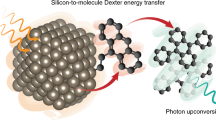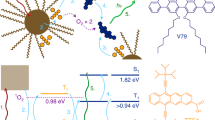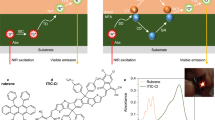Abstract
Triplet excitons are ubiquitous in organic optoelectronics, but they are often an undesirable energy sink because they are spin-forbidden from emitting light and their high binding energy hinders the generation of free electron–hole pairs. Harvesting their energy is consequently an important technological challenge. Here, we demonstrate direct excitonic energy transfer from ‘dark’ triplets in the organic semiconductor tetracene to colloidal PbS nanocrystals, thereby successfully harnessing molecular triplet excitons in the near infrared. Steady-state excitation spectra, supported by transient photoluminescence studies, demonstrate that the transfer efficiency is at least (90 ± 13)%. The mechanism is a Dexter hopping process consisting of the simultaneous exchange of two electrons. Triplet exciton transfer to nanocrystals is expected to be broadly applicable in solar and near-infrared light-emitting applications, where effective molecular phosphors are lacking at present. In particular, this route to ‘brighten’ low-energy molecular triplet excitons may permit singlet exciton fission sensitization of conventional silicon solar cells.
This is a preview of subscription content, access via your institution
Access options
Subscribe to this journal
Receive 12 print issues and online access
$259.00 per year
only $21.58 per issue
Buy this article
- Purchase on Springer Link
- Instant access to full article PDF
Prices may be subject to local taxes which are calculated during checkout





Similar content being viewed by others
References
Bardeen, C. J. The structure and dynamics of molecular excitons. Annu. Rev. Phys. Chem. 65, 127–148 (2014).
Köhler, A. & Bässler, H. What controls triplet exciton transfer in organic semiconductors? J. Mater. Chem. 21, 4003–4011 (2011).
Rao, A. et al. The role of spin in the kinetic control of recombination in organic photovoltaics. Nature 500, 435–439 (2013).
Baldo, M., O’Brien, D., Thompson, M. & Forrest, S. Excitonic singlet–triplet ratio in a semiconducting organic thin film. Phys. Rev. B 60, 422–428 (1999).
Segal, M., Baldo, M., Holmes, R., Forrest, S. & Soos, Z. Excitonic singlet–triplet ratios in molecular and polymeric organic materials. Phys. Rev. B 68, 075211 (2003).
Lee, J. et al. Singlet exciton fission photovoltaics. Acc. Chem. Res. 46, 1300–1311 (2013).
Wilson, M. W. B., Rao, A., Ehrler, B. & Friend, R. H. Singlet exciton fission in polycrystalline pentacene: From photophysics toward devices. Acc. Chem. Res. 46, 1330–1338 (2013).
Smith, M. B. & Michl, J. Recent advances in singlet fission. Annu. Rev. Phys. Chem. 64, 361–386 (2013).
Thompson, N. J., Congreve, D. N., Goldberg, D., Menon, V. M. & Baldo, M. A. Slow light enhanced singlet exciton fission solar cells with a 126% yield of electrons per photon. Appl. Phys. Lett. 103, 263302 (2013).
Dexter, D. L. A theory of sensitized luminescence in solids. J. Chem. Phys. 21, 836–850 (1953).
Baldo, M. A. et al. Highly efficient phosphorescent emission from organic electroluminescent devices. Nature 395, 151–154 (1998).
Semonin, O. E. et al. Absolute photoluminescence quantum yields of IR-26 Dye, PbS, and PbSe quantum dots. J. Phys. Chem. Lett. 1, 2445–2450 (2010).
Whitmore, P. M., Alivisatos, A. P. & Harris, C. B. Distance dependence of electronic energy transfer to semiconductor surfaces: n3π* Pyrazine/GaAs(110). Phys. Rev. Lett. 50, 1092–1094 (1983).
Hayashi, T., Castner, T. G. & Boyd, R. W. Quenching of molecular fluorescence near the surface of a semiconductor. Chem. Phys. Lett. 94, 461–466 (1983).
Piland, G. B. et al. Dynamics of molecular excitons near a semiconductor surface studied by fluorescence quenching of polycrystalline tetracene on silicon. Chem. Phys. Lett. 601, 33–38 (2014).
Anni, M. et al. Förster energy transfer from blue-emitting polymers to colloidal CdSe/ZnS core shell quantum dots. Appl. Phys. Lett. 85, 4169–4171 (2004).
Anikeeva, P. O. et al. Photoluminescence of CdSe/ZnS core/shell quantum dots enhanced by energy transfer from a phosphorescent donor. Chem. Phys. Lett. 424, 120–125 (2006).
Reineke, S. & Baldo, M. Room temperature triplet state spectroscopy of organic semiconductors. Sci. Rep. 4, 3797 (2014).
Burdett, J. J. & Bardeen, C. J. The dynamics of singlet fission in crystalline tetracene and covalent analogs. Acc. Chem. Res. 46, 1312–1320 (2013).
Wilson, M. W. B. et al. Temperature-independent singlet exciton fission in tetracene. J. Am. Chem. Soc. 135, 16680–15588 (2013).
Tayebjee, M. J. Y., Clady, R. G. C. R. & Schmidt, T. W. The exciton dynamics in tetracene thin films. Phys. Chem. Chem. Phys. 15, 14797–14805 (2013).
Yost, S. R. et al. A transferable model for singlet-fission kinetics. Nature Chem. 6, 492–497 (2014).
Wu, T. C. et al. Singlet fission efficiency in tetracene-based organic solar cells. Appl. Phys. Lett. 104, 193901 (2014).
Burdett, J. J., Gosztola, D. & Bardeen, C. J. The dependence of singlet exciton relaxation on excitation density and temperature in polycrystalline tetracene thin films: Kinetic evidence for a dark intermediate state and implications for singlet fission. J. Chem. Phys. 135, 214508 (2011).
Ehrler, B. et al. In situ measurement of exciton energy in hybrid singlet-fission solar cells. Nature Commun. 3, 1019 (2012).
Jadhav, P. J. et al. Triplet exciton dissociation in singlet exciton fission photovoltaics. Adv. Mater. 24, 6169–6174 (2012).
Tomkiewicz, Y., Groff, R. P. & Avakian, P. Spectroscopic approach to energetics of exciton fission and fusion in tetracene crystals. J. Chem. Phys. 54, 4504–4507 (1971).
Zarghami, M. et al. p-Type PbSe and PbS quantum dot solids prepared with short-chain acids and diacids. ACS Nano 4, 2475–2485 (2010).
Zhu, H., Song, N. & Lian, T. Controlling charge separation and recombination rates in CdSe/ZnS type I core-shell quantum dots by shell thicknesses. J. Am. Chem. Soc. 132, 15038–15045 (2010).
Merrifield, R. E., Avakian, P., Groff, R. P., Physics, C. & June, L. Fission of singlet excitons into pairs of triplet excitons in tetracene crystals. Chem. Phys. Lett. 3, 386–388 (1969).
Congreve, D. N. et al. External quantum efficiency above 100% in a singlet-exciton-fission-based organic photovoltaic cell. Science 340, 334–337 (2013).
Maksym, P. A. & Chakraborty, T. Quantum dots in a magnetic field: Role of electron–electron interactions. Phys. Rev. Lett. 65, 108–111 (1990).
Moreels, I. et al. Size-dependent optical properties of colloidal PbS quantum dots. ACS Nano 3, 3023–3030 (2009).
Jasieniak, J., Califano, M. & Watkins, S. E. Size-dependent valence and conduction band-edge energies of semiconductor nanocrystals. ACS Nano 5, 5888–5902 (2011).
Graham, K. R. et al. Re-evaluating the role of sterics and electronic coupling in determining the open-circuit voltage of organic solar cells. Adv. Mater. 25, 6076–6082 (2013).
Acknowledgements
This work was supported as part of the Center for Excitonics, an Energy Frontier Research Center funded by the US Department of Energy, Office of Science, Office of Basic Energy Sciences under Award Number DE-SC0001088 (MIT). D.N.C. was partially supported by the National Science Foundation Graduate Research Fellowship under Grant No. 1122374. J.M.S. was partially supported under FA9550-11-C-0028 awarded by the Department of Defense, Air Force Office of Scientific Research, National Defense Science and Engineering Graduate (NDSEG) Fellowship, 32 CFR 168a, and by the US Army through the Institute for Soldier Nanotechnology (W911NF-13-D-0001). The authors thank O. Chen, C-H. Chuang, D. D. Grinolds, D. K. Harris and G. W. Hwang for stimulating discussions and their considerable help with nanocrystal synthesis, as well as R. Murphy for help in obtaining access to equipment.
Author information
Authors and Affiliations
Contributions
N.J.T., D.N.C. and M.Wu fabricated the samples and made steady-state measurements. P.R.B. performed UPS and AFM measurements. M.W.B.W. and T.S.B. made transient measurements and M.W.B.W. prepared nanocrystal solutions for sample fabrication. J.M.S., M.W.B.W. and P.R.B. fabricated the nanocrystals. N.G. and M.Welborn simulated the nanocrystal structure. The project was conceived by N.J.T. and M.A.B. All authors discussed the results and commented on the manuscript.
Corresponding authors
Ethics declarations
Competing interests
MIT has filed a provisional application for patent based on this technology that names D.N.C., N.J.T., M.W.B.W., M.Wu, M.A.B., V.B. and M.G.B. as inventors.
Supplementary information
Supplementary Information
Supplementary Information (PDF 629 kb)
Rights and permissions
About this article
Cite this article
Thompson, N., Wilson, M., Congreve, D. et al. Energy harvesting of non-emissive triplet excitons in tetracene by emissive PbS nanocrystals. Nature Mater 13, 1039–1043 (2014). https://doi.org/10.1038/nmat4097
Received:
Accepted:
Published:
Issue Date:
DOI: https://doi.org/10.1038/nmat4097
This article is cited by
-
Near-infrared photon upconversion and solar synthesis using lead-free nanocrystals
Nature Photonics (2023)
-
Colloidal CdSe nanocrystals are inherently defective
Nature Communications (2021)
-
Self-assembly of semiconductor nanoparticles toward emergent behaviors on fluorescence
Nano Research (2021)
-
Organic phosphors with bright triplet excitons for efficient X-ray-excited luminescence
Nature Photonics (2021)
-
Mechanisms of triplet energy transfer across the inorganic nanocrystal/organic molecule interface
Nature Communications (2020)



